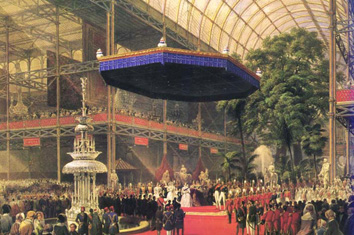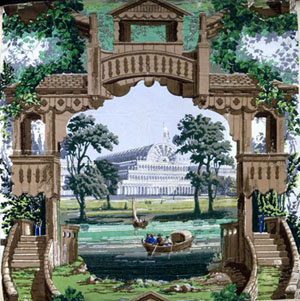 “As the day of the opening of the Great Exhibition approaches, the interest of the public of this and other countries increases in intensity with regard to it. The fairy-like but substantial structure, itself the greatest and noblest work of art and manufacture which the Exhibition has called forth is completed, and challenges the admiration of daily crowds…”
“As the day of the opening of the Great Exhibition approaches, the interest of the public of this and other countries increases in intensity with regard to it. The fairy-like but substantial structure, itself the greatest and noblest work of art and manufacture which the Exhibition has called forth is completed, and challenges the admiration of daily crowds…”
– Description from a news article published on page 332 of the Illustrated London News on April 26, 1851, Issue 480.
Like to learn more about the Great Exhibition of 1851? Then, sign up for the History Detectives: The Crystal Palace and the Great Exhibition workshop scheduled from 6-7 pm on Wed., Oct. 12. This session will lead participants on a madcap journey thorugh Victorian London as we discover the secrets of the Crystal Palace. To whet your palette, keep reading!
The opening of the Crystal Palace or the Great Exhibition of 1851, which holds the distinction of being the first among many international expositions, was a much anticipated event. It was held in Hyde Park in London from May 1 to October 15, 1851 to commemorate the industrial and technological progress of Great Britain. A beautiful structure known as the Crystal Palace was built to house the exhibition by Sir Joseph Paxton, a famous British designer and gardener. The building was constructed using glass and wrought iron and numerous statues and trees were housed within the structure for embellishment.
From the beginning, the exhibition had the enthusiastic support of Prince Albert, the Prince Consort of Queen Victoria. He worked with Sir Henry Cole, an English Civil Servant, and other members of the Royal Society for the Encouragement of Arts, Manufactures, and Commerce, to organize the first world’s fair. The British Government appointed the Royal Commission for the Exhibition of 1851 to stage the exhibition. More than 13,000 exhibits were displayed. Products from Great Britain, other western countries as well as colonized countries were showcased to demonstrate the progress of the Western Civilization and illustrate the underdevelopment of the colonized countries. Nearly six million people visited the exhibition. We have several rare materials in the Special Collections from this exhibition. Would you like to see some of these?
 We have two cool telescopic views of the fair – Lane’s Telescopic View of the Interior of the Great Industrial Exhibition and Lane’s Telescopic View of the Ceremony of Her Majesty Opening the Great Exhibition of All Nations. Both provide a three dimensional view of the exhibition. A slideshow of one of these items is available on our Flickr site. Other fascinating rare materials such as, Tallis’ History and Description of the Crystal Palace, Fireside Facts from the Great Exhibition, some beautiful chromolithographs of the fair from the World’s Fairs Collection: 1851-1937, The Art Journal Illustrated Catalogue, and The Crystal Palace, and its Contents are also available at the Special Collections. In fact, Mr. George Peabody organized a dinner in the London Coffee House on October 27, 1851, to celebrate the Great Exhibition and invited many important guests including Earle Granville, the Chairman of the Royal Commission and Sir Joseph Paxton. Check out the detailed account of this dinner available at the Peabody Library. Now that you are interested in this collection, you may want to take a look at the World’s Fair Collection guide. While you are browsing the guide, you may want to see the beautiful Google Doodle celebrating 160th anniversary of the opening of the Great Exhibition. Interested in experiencing the Great Exhibition? I recommend that you watch this video clip from the Victoria and Albert Museum.
We have two cool telescopic views of the fair – Lane’s Telescopic View of the Interior of the Great Industrial Exhibition and Lane’s Telescopic View of the Ceremony of Her Majesty Opening the Great Exhibition of All Nations. Both provide a three dimensional view of the exhibition. A slideshow of one of these items is available on our Flickr site. Other fascinating rare materials such as, Tallis’ History and Description of the Crystal Palace, Fireside Facts from the Great Exhibition, some beautiful chromolithographs of the fair from the World’s Fairs Collection: 1851-1937, The Art Journal Illustrated Catalogue, and The Crystal Palace, and its Contents are also available at the Special Collections. In fact, Mr. George Peabody organized a dinner in the London Coffee House on October 27, 1851, to celebrate the Great Exhibition and invited many important guests including Earle Granville, the Chairman of the Royal Commission and Sir Joseph Paxton. Check out the detailed account of this dinner available at the Peabody Library. Now that you are interested in this collection, you may want to take a look at the World’s Fair Collection guide. While you are browsing the guide, you may want to see the beautiful Google Doodle celebrating 160th anniversary of the opening of the Great Exhibition. Interested in experiencing the Great Exhibition? I recommend that you watch this video clip from the Victoria and Albert Museum.
